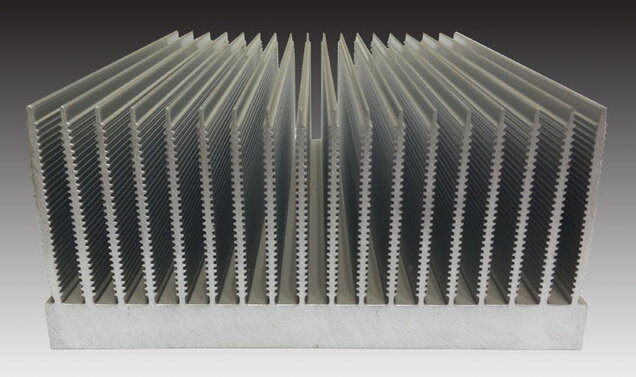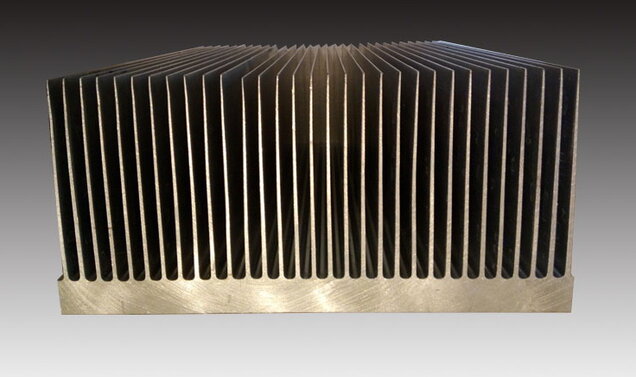Extruded heat sinks
Extruded heat sink are generally high power heat sink and cooling systems.
Extruded heat sinks is also known as heat sink extrusion or extruded aluminum heat sink, heat sink extrusion with beautiful appearance, light weight, good heat dissipation performance, energy saving effect. Simply put, aluminum heat sink extrusion technology is to heat aluminum ingots to 520~540℃ at high temperature, under high pressure to let the aluminum liquid flow through the heat sink extrusion mold with grooves, to make the extruded heat sink material. Then, after cutting and cutting the heat sink extrusion material, the extruded aluminum heat sink we often see is made.
Aluminum heat sink extrusion technology is easy to realize, and the cost of equipment is relatively low, so it has been widely used in the low-end market in previous years. AL6063 is a commonly used aluminum heat sink material, which has good thermal conductivity and machinability. Lori relying on long-term accumulated technical experience and production process, sets aluminum alloy profiles with good thermal conductivity and other characteristics, and develops a customized aluminum extruded heat sink that can meet customers' requirements of product differentiation, specialization and personalization. The finished extruded heat sinks surface is anodized to improve the corrosion resistance, wear resistance and appearance of aluminum. At present, the commonly used types of extruded aluminum heat sink in China are electronic heat sink, computer heat sink , sunflower heat sink, power semiconductor heatsink and so on. Because of the superior performance, extruded aluminum heat sinks is widely used in: machinery, automobile, wind power, construction machinery, air compressor, railway locomotive, household appliances and other industries.
Aluminum heat sink extrusion molding can be achieved through the mold, which can realize the complex structure of heat sink fin.These complex radiating fin make the radiating surface area larger and reduce the cost and time of aluminum processing.
The mainly advantages of aluminum extruded heat sinks as following:
- More efficient than stamping heat sink
- More cost saving than mechanical processing
- There are a variety of standard shapes and sizes
- Easily customized than copper lighter, obvious advantage

Aluminum Extrusion Profiles
For a large number of integral heatsink applications, the use of aluminum extrusion profiles has been a beneficial component for electronics manufacturers throughout the years. Simply defined as a component made of material - inexpensive and malleable aluminum alloy, in this case - forced through a die, these extrusion profiles can be used for countless products on the market today. One of their applications, however, has proven highly advantageous to heatsink manufacturers who are able to utilize aluminum extrusion profile technology to deliver efficient cooling mechanisms while maintaining the strength and light weight that electronic products manufacturers have come to expect.
Based on the standard heatsink design, an extrusion can be molded into a wide variety of forms for the varied functions and space requirements needed by different manufacturers. Due to the fact that the aluminum alloy is relatively easy to work with, extrusions can be die cast and put through many other unique designs in order to give these extrusion profiles the flexibility that they are known for. In addition to casting dies and extrusions, the makers of aluminum based heatsink profiles are able to pound this alloy into foil, fins and sheets through the processes of refining, smelting and scrapping.
Aluminum becomes particularly desirable when compared with other popular heatsink materials. Copper, for instance, is incapable of being worked with so well. Although it has nearly twice the thermal conductivity of aluminum, it is not as easy to use copper to adapt to any form requirements such as extrusion profile and die casting.
Customizing aluminum extrusion profiles is also very feasible, due to the ease of production already outlined above. In the form of fins, profiles can easily be attached to a copper base so that a large amount of thermal energy is conducted to the cooling fins which are made of the lighter, less expensive aluminum alloy.

High Aspect Ratio Extrusions
For electronics product manufacturers who require a series of high volume applications to be produced, one of the best heatsink solutions comes in the form of the high aspect ratio extrusion model. This is because products that require little or no secondary level processing are most affordably served by extrusion technology for heatsinks. Through reducing costs and still maximizing the benefits of high surface area cooling, the makers of heatsinks today have been able to deliver incredibly efficient large scale thermal planning for a wide variety of clients throughout the market.
An important part of putting together the heatsink design for a company's manufacturing needs is developing an assessment of its thermal requirements and from there determining the right strategy to implement. For high-volume manufacturers who are interested in the most energy-efficient and inexpensive option, the use of high aspect ratio extrusion technology is the clear answer. That's because the more commonplace extrusions often will not be able to serve the needs of high volume applications, due to the fact that their cooling capacity - measured in part by the aspect ratio - is simply not great enough. Here, the advantage of high aspect ratio extrusions becomes apparent; by nearly doubling the heatsink extrusion's aspect ratio, manufacturers are able to take advantage of the optimized effect of what would otherwise be a normal extrusion based heatsink.
By consulting with the makers of heatsinks, an electronics producer can more accurately pinpoint the production needs in terms of fin thickness and overall density. The standard extrusion - which is one of the most common models for heatsinks in general - is often produced with aluminum, due to its high thermal conductivity. After getting past the basics, the decision of how to fan out the fins is based largely on the spacing between them, although there is often a varied selection of fin widths that adhere specifically to one's application requirements.